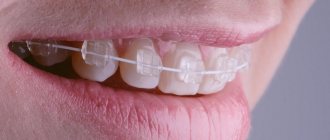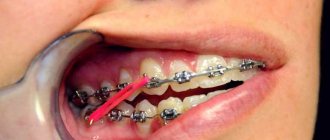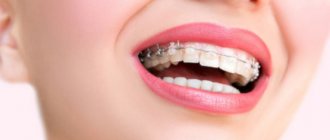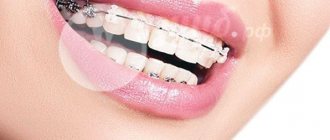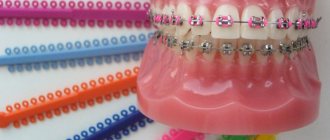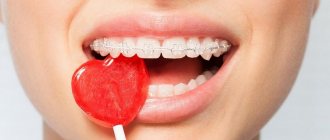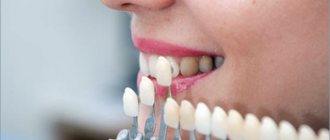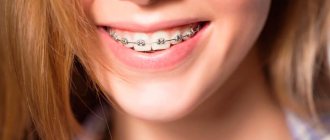3126
One of the most common and effective ways to correct bite defects is braces.
These structures are attached to each tooth and worn throughout the treatment period. An important role in the course of treatment is played by the correctness and reliability of fixation of the braces' locks.
Preparing for positioning
Installation of braces requires a preparatory stage. After an initial consultation with an orthodontist, the patient will need to carefully prepare the oral cavity.
Braces are installed only on healthy elements of the jaw arch.
Basic steps in preparation:
- Treatment of carious lesions. It is necessary to detect and treat all existing sites of caries development, even the smallest ones;
- Checking old fillings. If there are seals that were installed a long time ago, you need to check their strength and replace if necessary;
- Periodontal diseases. The mucous membrane of the oral cavity must be absolutely healthy. Even the most minor inflammations can worsen after the installation of braces;
- Remineralization. If there are areas of thinning enamel, increased sensitivity or cracks on the teeth, a remineralization procedure should be performed. It will help strengthen tooth enamel and avoid the development of certain diseases during orthodontic treatment.
Complete sanitation of the oral cavity is a prerequisite that must be completed first before installing braces.
Depending on the initial condition of the oral cavity, the preparation stage may take several months.
During the treatment period, panoramic photographs of the jaws . Based on them, the doctor draws up a treatment plan and determines where to fix the locks.
Immediately before fixing braces, it is necessary to have your teeth professionally cleaned . During this procedure, the surface of the teeth is cleaned, tartar and plaque are removed.
This is done to ensure that the surface of the teeth is absolutely clean, and when gluing the structure nothing interferes with the strong adhesion of the surfaces.
Why is it undesirable to undergo an MRI with braces on your teeth?
Come here if you are interested in what to do if a person accidentally swallows a brace.
At this address https://orto-info.ru/sistemyi-vyiravnivaniya-zubov/breketyi/nuzhno-li-udalyat-pri-ustanovke.html we will answer the question: is it necessary to remove teeth when installing braces.
Invisalign clear aligner system
Another system that allows you to find out the final result of orthodontic treatment is Invisalign . A unique system of transparent aligners that are sequentially placed on the teeth and gradually straighten them.
Visualization of the treatment result, as well as the process of tooth movement, are recreated on a computer, similar to Insignia technology. The stages are the same: scanning, set-up modeling, approval by the doctor and the patient, manufacturing a set of aligners. The Invisalign aligner system is designed and manufactured in the USA.
In each case, you can evaluate the final result of orthodontic treatment, obtaining a completely individual system for teeth alignment and bite correction.
Indirect fixation of braces, individual Incognito lingual braces, computer-modeled vestibular braces using Insignia technology (CAD/CAM), Invisalign clear aligners - which option you choose is up to you.
You can obtain more detailed information about systems of individual braces and mouth guards by scheduling a consultation with the orthodontist at Atribeaute Clinique - Anastasia Olegova Fedorova.
Direct method
After all the preparatory procedures have been completed, the doctor can begin fixing the bracket system. There are two main ways to attach braces to teeth – direct and indirect.
The direct method involves manually gluing clasps onto each tooth. This work is quite painstaking and requires a lot of attention and experience of a specialist.
To some extent, such work can be compared to jewelry. All teeth have different sizes, so the clasps must be precisely selected and glued.
During installation of the structure, the doctor uses tweezers, a clamp, a holder and a positioner. With their help, the orthodontist holds the clasps, measures their exact position in accordance with the marks on the panoramic photographs and fixes them on the teeth.
Sequence of actions for direct installation:
- A retractor is installed;
- A special composition based on orthophosphoric acid is applied to the enamel. It helps make the enamel surface rougher, which creates the most reliable adhesion;
- After 30 seconds, the composition is washed off with water;
- The surface of the teeth is dried;
- A therapeutic composite is applied to the enamel, which creates a protective layer;
- An adhesive composition is prepared (as a rule, it consists of two components);
- Glue is applied to the back of the locks;
- The lock is fixed to each tooth in turn;
- Excess glue is removed;
- After the glue has hardened, a metal arc is inserted and ligatures are attached.
The entire procedure for installing a bracket system takes approximately 1-1.5 hours. Complete hardening of the glue occurs in about a day.
During this period, the patient should take only soft and liquid foods.
The advantages of this method are:
- Accurate installation of locks according to the planned plan;
- Possibility of making adjustments during installation;
- Reliable fastening of locks;
- Prevents food from getting between locks and enamel.
The disadvantages are:
- Takes a long time;
- The patient must remain stationary throughout the entire installation;
- A lot of effort and attention is required from a doctor.
The video shows the process of the direct method of fixing braces.
Indirect method of fixing bracket systems
The fundamental difference from the direct method is that most of the work on preliminary selection of the position of the braces is carried out without the participation of the patient.
How does this happen?
- an impression is taken, an exact copy of the patient’s jaw is made - a plaster model in the laboratory, this model is coated with a special insulating varnish
- A brace is fixed to each “artificial” tooth – exactly in the position that is necessary for the patient. At the same time, the doctor is not limited in time. He can examine the model from different angles, study all its features, and fix the braces in a mode convenient for him.
- Liquid silicone is applied to the braces, which subsequently hardens and turns into a mouth guard; the model, along with the braces and mouth guard, is placed in water for half an hour, the varnish dissolves and the braces remain in the mouth guard.
- When the patient arrives, the aligner is transferred into the oral cavity, the braces are illuminated and fixed exactly where necessary.
Advantages of the method : reduction of time spent working with the patient directly at the appointment. On average, this type of fixation requires 40-60 minutes.
Disadvantages of the method : time spent on preliminary production of the model, mouth guard and the entire system.
It doesn’t matter which method the doctor chooses in your particular case. You should focus not so much on the type of fixation of braces, but on the qualifications and expertise of the doctor. With a skillful approach, any of the above methods will be effective.
Indirect installation
Recently, the indirect method of fixing braces has become popular. This method allows you to glue products to all teeth at the same time using a special tray.
The indirect method of fixing braces reduces the time of direct installation, but requires longer preliminary preparation in the laboratory.
What is the preparation:
- Impressions are taken of the patient's jaws , on the basis of which an accurate plaster model is made;
- The location of the locks is marked on the model using reference lines;
- Using burnt sugar or heating the model, the clasps are fixed to the jaw model;
- A special mouthguard is made that accurately follows the contours of the teeth;
- The mouth guard is pressed against the model , thereby transferring the locks onto it.
Installation of the structure to the patient is carried out as follows:
- A retractor is installed;
- Tooth enamel is etched with an orthophosphorus compound;
- After 30 seconds, the solution is washed off;
- The surface of the teeth is dried;
- A protective composite is applied;
- An adhesive is applied to the back of the locks;
- A mouthguard with braces is placed on the jaw;
- After an hour, the mouth guard is removed;
- A metal arc and ligatures are installed.
Among the advantages of this method are:
- Quick installation due to simultaneous gluing to all teeth;
- Comfort for the patient;
- Precision installation helps to avoid unnecessary pain and speeds up the treatment process.
The disadvantages are:
- It is difficult to determine the correct installation point;
- Inability to control the process of fixation on each tooth;
- It is difficult to remove excess glue;
- Long preparation process.
Watch the video to see how braces are installed indirectly.
Fixing braces: how it happens
The purpose of braces is to correct the bite and move the teeth, but they themselves should not move. The outcome of the entire treatment depends on their correct fixation. It is not surprising that these small locks are fixed in the mouth very carefully, neatly and strictly according to a special pattern. All this takes quite a lot of time and requires high professionalism from the orthodontist and patience from the patient.
The technology of fixing brackets on the outside or inside of teeth is called bonding - in simpler terms, it is “gluing” a metal device to tooth enamel. This is done using high-tech composite materials, such as light-curing plastics. They are considered the safest, most reliable and most convenient “glue” for the orthodontist to work with. With their help, braces are fixed on the teeth, but this can be done in two ways - direct and indirect.
Direct fixation of bracket system
The direct method of fixing braces, as its name suggests, assumes that the braces are installed directly on the teeth, and on each one separately. After all, all braces differ from each other - they are intended for incisors, others for canines, others for molars, etc. Having a panoramic image or orthopantogram before his eyes, the doctor installs braces on each tooth one by one. This is, one might say, jewelry work.
Special devices are inserted into the mouth to prevent the mucous membranes from touching the teeth (a retractor lifts the lips, a special stop limits the movements of the tongue, etc.). The enamel of each tooth is processed: first, it is polished using a special abrasive wheel, then washed with hydrogen peroxide and dried thoroughly (at least 1 minute). Dry enamel is etched using a composition containing orthophosphoric acid - this allows you to create micro-roughness that is harmless to the tooth, but very necessary for a more dense fixation with the “glue”, and therefore with the bracket. The enamel is again washed and dried. After this, a fixing composite material is applied to the prepared area, and the most crucial moment comes - the direct installation of the bracket. The doctor attaches it to the tooth using special tweezers.
This is the traditional method of bonding. Its main advantage is the ability to adjust the initial plan for installing braces as necessary and keep the fixation of each of them under complete control. However, it is quite labor-intensive and difficult to implement for both the doctor and the patient. Therefore, indirect bonding has become increasingly popular recently.
Indirect method of fixing braces
In this case, braces are installed in advance, in the laboratory, on an impression of the patient’s jaw. And then, using a special technique, they are transferred to his “natural” teeth. It happens like this.
An accurate cast of the jaw is first made from plaster. On it, or more precisely, directly on the plaster teeth, the transverse and longitudinal axes are applied. The bracket is fixed at the point of their intersection. It is very easy to fix it - just heat the impression. Then two thin trays are made. Braces are transferred to one of them - the way they should be located in the patient’s mouth. The second has the same shape, but in place of the braces, special windows are cut - exactly according to their shape. Both aligners are inserted into the patient’s mouth in a special way, the braces are fixed on his real teeth (on all of them at once!), and the aligners are removed. In this case, the teeth require the same careful preparation as with the direct method of fixing braces, because the “glue” in both cases will be approximately the same.
The advantages of this method are obvious: this fixation of braces is faster, more convenient for the doctor, more comfortable for the patient, and sometimes more accurate.
After the braces are attached to the teeth, you need to insert a metal arch into them, which holds the entire orthodontic structure together. This is possible within 40-60 minutes, but in some cases the doctor may postpone the final procedure to the next day. And that's it: it's done!
Expert opinion
“It is very important that the patient assists his doctor during the installation of braces. No, you don’t need to grab his hands or, especially, provide general guidance, but you will have to show restraint and calmly sit through the entire procedure. And this is not an easy task: the oral cavity as a whole requires very serious preliminary preparation.
Firstly, hygienic - before the procedure, professional teeth cleaning is mandatory. Secondly, placing the bracket directly on the tooth also involves certain actions - washing, drying, grinding, etc., both in direct and indirect fixation. It is impossible to say in absentia which bonding is right for you - it depends on many factors, including the characteristics of your bite defects. The final choice is made by the attending physician.
Of course, manually installing braces takes longer and is a more delicate job. But indirect fixation should also never be treated carelessly - neither by the doctor nor by the patient. Be prepared to show restraint. It may be a little unpleasant, but it won't hurt. Believe me, the opportunity to have straight teeth and a beautiful, open smile is worth it!”
Thomas Pitts Table
The above methods of installing braces are based on the personal approach of the attending physician. In addition to this approach, a special protocol for fixing orthodontic systems has been developed.
This approach was developed and proposed by the American doctor Thomas Pitts. Pitts positions guarantee rapid correction of malocclusions.
For ease of understanding and use, these rules were translated by Dr. T. Castelanos into numerical parameters taking into account the length of the teeth.
The Pitts system consists of two parts and has the following scheme.
Upper jaw
| GPS-A | 1 | 2 | 3 | 4 | 5 | 6 | 7 |
| 8 | 4 | 4 | 4,5 | 4,5 | 4 | 3 | 3 |
| 9 | 4,5 | 4,5 | 5 | 5 | 4,5 | 3,5 | 3,5 |
| 10 | 5 | 5 | 5,5 | 5,5 | 5 | 4 | 4 |
| 11 | 5 | 5 | 6 | 6 | 5,5 | 4,5 | 4,5 |
Lower jaw
| GPS-A | 1 | 2 | 3 | 4 | 5 | 6 | 7 |
| 9 | 5 | 4,5 | 4,5 | 4 | 3,5 | 2,5 | 2 |
| 10 | 5,5 | 5 | 5 | 4,5 | 4 | 3 | 2 |
| 11 | 6,5 | 5,5 | 5,5 | 5 | 4,5 | 3,5 | 2,5 |
| 12 | 7 | 6 | 6 | 5 | 5,5 | 4 | 2,5 |
The installation location of the brackets is determined according to the following diagram:
- The length of the tooth crown is measured;
- The resulting figure is looked up in the GPS-A column;
- Next is the installation height according to the tooth standard.
This system helps to quickly determine the desired position for fixing braces, reduces installation time and reduces the likelihood of subjective errors.
Resilines adhesive system
The most popular adhesive for fixing braces is the Resilience system. Its adhesive is very soft and sticky, ideal for bonding braces. Using the composition, you can fix both metal and sapphire and ceramic products.
The adhesive hardens under the influence of light. Until the moment of illumination, it remains soft, which makes it possible to accurately install the lock.
The adhesive hardens completely when exposed to light. The metal arch can be installed immediately after fixing the locks.
The Resildynes system consists of several drugs. The cost of one set can vary between 10-15 thousand rubles.
The kit includes:
- Adhesive (in a syringe);
- Etching gel (in a syringe);
- Primer;
- Different tips for syringes;
- Palette for mixing components;
- Holder;
- Brush with three attachments of different lengths.
Is it possible to get a tax deduction for installing braces and what is needed for this?
In this publication, read which category of patients can count on having braces installed under compulsory medical insurance.
Here https://orto-info.ru/sistemyi-vyiravnivaniya-zubov/breketyi/ormco.html we will look at Ormco metal braces in detail.
Price issue
In many dental clinics, the cost for installing braces is highlighted as a separate line.
But there are also clinics where the amount for fixing the orthodontic system is included in the total cost of manufacturing the system. On average, this service is estimated at approximately 30% of the total cost of the braces system.
The installation price for products made from different materials will vary. The more expensive the system itself, the more expensive it will cost to install.
| Product material | Direct installation amount, rub. |
| Metal | From 10 000 |
| Ceramics | From 18000 |
| Sapphire | From 25000 |
The direct method is the most common installation method. The indirect method is currently used in a limited number of clinics. This is explained by its novelty and limited experience of specialists.
Due to the need to make a plaster model and special trays with the indirect method, its cost will increase by approximately 6-9 thousand rubles, compared to the direct method for each type of product material.
Using the indirect installation method
This technique was recently introduced. Until its introduction, the fixative was made from a material obtained chemically. The disadvantages included cleaning the tooth from excess substance. In laboratory conditions, they were constantly looking for a more convenient option until plastic was invented that could polymerize under heat.
The disadvantages included the instability of the material to high temperatures: at 350 degrees, the structure lost its shape. Ceramic versions of braces were not at all ready for any high temperature. The fixation process was awkward. Much has changed for the better when it became possible to use plastic with composite materials.
The installation process includes the following steps:
- Taking an impression of the jaw.
- Formation of a plaster model from a cast.
- Installation of the structure on the model.
- The design is transferred to the mouthguard.
- The structure is installed using a mouth guard on a row of teeth.
- Fastening the structure.
- Fixation of the arc.
In Japanese orthodontics, the following technique is used: the transverse and longitudinal axis are marked with a pencil on the plaster model. A bracket will be attached at the intersection points. It is installed on the model, and the rest of the free space is painted with paint, which is subsequently washed off with water.
A special mouthguard is made by a doctor from a 0.5mm thick material called elastomer. Next, the mouth guard is removed with the bracket from the model and another mouth guard with a 1-mm thickness is made. An electric spatula cuts out windows of similar size and location. The tooth enamel of the row is etched, washed with a strong jet pressure, and dried. After the tooth surface is ready, glue is applied to it, the same is done with the mouth guard, and fixation occurs on the tooth surface. After an hour and a half wait, the mouthguard is removed, the composite is cleaned from the teeth, the support rings are fixed, and the bracket arch is inserted.
Useful tips
Correcting a bite with braces can take a long period of time. The speed and result of correction of defects depends on how accurately the patient follows all the doctor’s recommendations.
For the first time after fixing the orthodontic system, the patient should avoid solid foods and increased load on the jaws. Preference should be given to soft or liquid foods.
In the future, you must follow these recommendations:
- Visit your doctor regularly. This is necessary to assess the condition, adjust the pressure on the teeth, change ligatures and make the necessary adjustments;
- Careful oral hygiene. It is necessary to brush your teeth several times a day, after eating food. If there are no conditions to brush your teeth, you must rinse your mouth thoroughly;
- Use additional hygiene products (irrigator, floss, brush, etc.);
- Adhere to a special diet. The patient should exclude foods that are too hard, sticky or tough from the diet;
- Carry out periodic professional teeth cleaning;
- Eliminate bad habits.
Following these recommendations will help speed up the treatment process and will also reduce the likelihood of parts of the system coming off or being damaged.
Preparatory stage
Before installing an orthodontic structure, a number of activities are carried out to prepare the oral cavity for the upcoming correction. Fixation of braces is carried out only on healthy teeth. Installing a system without first removing plaque increases the risk of developing caries and other infectious processes.
To do this, the following procedures are carried out:
- treatment of caries;
- correction of old fillings;
- elimination of periodontal pathologies;
- strengthening tooth enamel (remineralization);
- sanitation of the oral cavity.
The above activities may take several months to complete.
The treatment plan is drawn up based on radiographic images. Before installing braces, professional ultrasonic cleaning is carried out.
